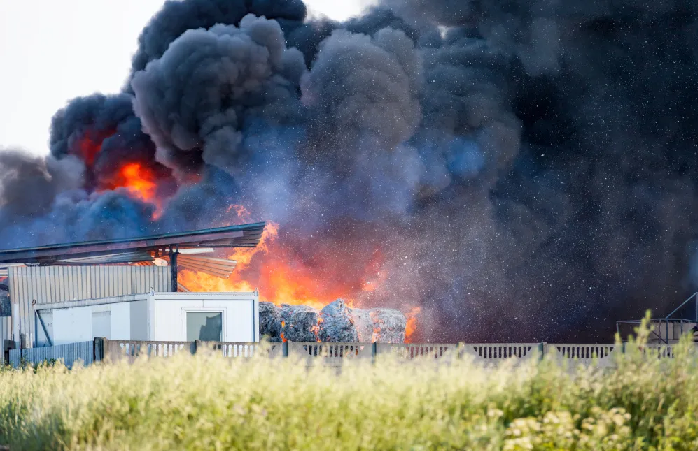An industrial shredder is an instrument utilized to decrease the size of numerous materials, aiding their removal or recycling by cutting, tearing, and dismantling items like paper, plastic, metal, and wood into smaller, more controllable parts.
This process is key in waste management, enabling effective material management and transportation. Industrial shredders are also fundamental in preserving the environment by facilitating material recycling, lowering landfill use, and encouraging resource conservation.
An industrial shredder machine runs independently for extensive periods, presenting recognized dangers for fire outbreaks: heat, fuel sources, and oxygen. The friction of the scrap produces heat, which, alongside the ever-present oxygen, can ignite available flammable liquids (e.g., fuels, greases, and oils) and materials (e.g., paper and cardboard).
Optris Xi 410: Unboxing & Setup Guide
Video Credit: Optris GmbH & Co. KG
In unmanned facilities, a fire can spread substantially before being identified. Metal shredding systems are usually positioned in less reinforced production halls, increasing the risk of employee injury and machinery harm. It is crucial to take preventive measures to avoid fires and their spread in these facilities.
Another problem is that these plants are usually positioned in isolated or hard-to-reach areas, making timely recognition and firefighting more challenging. Constant monitoring and prompt warning are critical to reduce fire risk and ensure worker and equipment safety.
Without suitable monitoring systems, fires can go undetected until they have caused considerable damage, endangering employee safety and equipment functionality.
Unattended shredding machines pose a unique risk as human involvement in an emergency can be late, increasing the chances of a fire getting out of control and causing worse destruction.
It is reassuring to recognize the importance of using reliable and continuous automated monitoring solutions, as they ensure constant oversight of the shredder.
An effective solution to this issue must include early detection, timely alerts, and automated responses to hazardous situations. This may involve shutting down machines automatically or triggering extinguishing systems.
Combining preventive monitoring and instant response mechanisms can substantially lower fire risk in shredder plants.
Consistent Autonomous Alarming with IR Cameras in Waste Shredder Plants
The Xi/PI series’ infrared cameras identify raised temperatures in shredder plants early, helping to prevent fires and dangerous circumstances through reliable alerts.
Optris’ Xi range’s compact Xi 80 and Xi 410 IR cameras are a perfect solution, as they run independently. This independence encourages trust in their dependability.

Image Credit: Optris GmbH & Co. KG
When alarms occur, the sensor autonomously transmits signals to process instances that can, for example, turn off the motor or suspend the power supply to impacted shredders.
With attributes like the motor focus and the integrated auto hotspot finder, sturdy and compact imagers like the Xi 80/410 are perfect for safety-critical functions, especially in preventive fire protection and condition monitoring of machines and systems.
Infrared cameras’ optical components can be successfully kept clean even in critical conditions via air purge collars.
Alongside consistent early recognition and alarm, the Optris infrared cameras provide high flexibility when integrated into existing monitoring and extinguishing systems, enabling cameras to be adapted to specific requirements.
The infrared cameras can be easily combined with current control systems and have vast interfaces to communicate information, facilitating smooth integration and ensuring the surveillance systems work effectively and consistently.
Optris infrared cameras are also intended for challenging conditions. Their sturdy casing protects against dust and moisture and can be utilized within a broad temperature range, making them perfect for industrial settings where consistency and stability are essential.
Another benefit of Optris infrared cameras is their maintenance and ease of use. They come with accessible software solutions that facilitate easy configuration and monitoring, decreasing the effort needed for contracting and maintenance and reducing operative costs.
Improving Fire Protection with Autonomous IR Camera
Utilizing infrared cameras from the Xi series, explicitly the Xi 80 and Xi 410, presents considerable benefits for fire protection functions. Optris products are trustworthy and effective, besting in independent operation.
The Xi 80 and Xi 410 run autonomously, transmitting signals during a fire event to initiate alarms and automatically stop systems, turning off motors or stopping power supplies. These cameras can also offer continual system monitoring.

Image Credit: Optris GmbH & Co. KG
These cameras feature motor focus and an auto hotspot finder, these cameras are perfect for safety-critical tasks, promptly and precisely identifying rising temperatures in shredder plants promptly and precisely. This early detection is crucial in preventing fires.
The Xi series cameras are compact and sturdy, with casings that shield against dust and moisture, making them ideal for demanding industrial settings. Supplementary accessories, like air purge attachments and water-cooling housings, improve their endurance and effectiveness in tough conditions.
Camera setup and integration are simple. They easily connect to existing monitoring and extinguishing systems, providing extensive data communication interfaces. Included software tools streamline installation and configuration while facilitating comprehensive data analysis. Another benefit is cost-effectiveness.
Continuous monitoring and instant alerts when critical temperature limits are surpassed lower the demand for frequent maintenance and decrease unexpected system downtime. Optris' systems' streamlined setup process cuts running costs and may even reduce staffing expenses.

This information has been sourced, reviewed and adapted from materials provided by Optris GmbH & Co. KG.
For more information on this source, please visit Optris GmbH & Co. KG.